文章来源于互联网:Microsoft Launches Copilot AI App for iOS Users,仅供学习使用。Home » AI News » Microsoft Launches Copilot AI App for iOS UsersDecember 30, 2023: Microsoft has just released its Copilot app for iOS and iPadOS, following its recent Android app launch. This new app introduces users to an advanced AI chatbot experience, offering a range of helpful features on their iPhones.Key Features of Microsoft Copilot:The launch has sparked various reactions from users. Some express excitement about the new AI tool for personal and creative use, like generating iPhone wallpapers.Others, however, are concerned about potential data harvesting and the lack of clarity regarding the app’s features compared to paid services. A notable point of confusion is the branding, as ‘Copilot‘ was previously associated with GitHub’s coding assistance tool.Despite these concerns, many users acknowledge the app’s effectiveness and user-friendly interface.Some users, including a Microsoft employee, have compared it favorably to ChatGPT, noting its efficiency in generating large response blocks and quick assistance.However, limitations like the inability to save chat history or upload files, except photos, have been highlighted. Users are anticipating future updates that might include these missing features.Based on our quality standards, we deliver this website’s content transparently. Our goal is to give readers accurate and complete information. Check our News section for latest news. To stay in the loop with our latest posts follow us on Facebook, Twitter and Instagram. Subscribe to our Daily Newsletter to join our growing community and if you wish to share feedback or have any inquiries, please feel free to Contact Us. If you want to know more about us, check out our Disclaimer, and Editorial Policy.Your email address will not be published. This post is the continuation of our previous post where we taught some of the best ways to write better Chat GPT or any other text prompt for GPT-3 or…
This New Vibrating Pill Promises a New Approach to Weight Loss
文章来源于互联网:This New Vibrating Pill Promises a New Approach to Weight Loss,仅供学习使用。Home » AI News » This New Vibrating Pill Promises a New Approach to Weight LossDecember 31, 2023: In a remarkable advancement in obesity treatment, researchers at the Massachusetts Institute of Technology (MIT) have developed a vibrating pill that has shown promising results in reducing food intake.This innovative capsule is designed to be swallowed before eating, triggering the body’s “stretch receptors” to send fullness signals to the brain.The technology behind this pill could potentially provide an alternative to current obesity treatments like Ozempic and Wegovy.Dr. Marc Siegel, highlighted the significance of this pill, noting its potential as a smart pill regulated by AI. The pill vibrates in the stomach, activating receptors that stimulate the vagus nerve.This stimulation mimics the feeling of fullness, even when the stomach isn’t actually full. In animal studies, this led to a remarkable 40% reduction in food intake compared to control groups.Lead author Shriya Srinivasan, PhD, emphasized the potential benefits of this pill in reducing the side effects associated with current pharmacological treatments for obesity.The capsule, which is the size of a multivitamin, contains a small oxide battery. Once swallowed, stomach acids dissolve its casing, activating the vibrating motor.Senior author Giovanni Traverso noted the potential of this technology in overcoming challenges and costs related to current obesity treatments.Approximately 30.7% of U.S. adults are overweight, and 42.4% are obese, with obesity increasing the risk of various health issues like stroke, heart disease, and diabetes. This pill could provide a cost-effective and accessible solution, especially in global health settings.Siegel compared the pill’s mechanism to that of semaglutides like Wegovy and Ozempic, which also slow stomach emptying.However, the vibrating pill could be a more suitable alternative for those who cannot tolerate the side effects of these medications.Plans are in place to test the capsules in human clinical trials in 2024, opening new doors in the realm of obesity treatment and smart pill technology.Based on our quality standards, we deliver this website’s content transparently. Our goal is to give readers accurate and complete information. Check our News section for latest news. To stay in the loop with our latest posts follow us on Facebook, Twitter and Instagram. Subscribe to our Daily Newsletter to join our growing community and if you wish to share feedback or have any inquiries, please feel free to Contact Us. If you want to know more about us, check out our Disclaimer, and Editorial Policy.Your email address will not be published. Find all the best ChatGPT prompts for almost any task and workflow.
Character.ai Gains More Users, Nears ChatGPT in U.S. Mobile App Use
文章来源于互联网:Character.ai Gains More Users, Nears ChatGPT in U.S. Mobile App Use,仅供学习使用。Home » AI News » Character.ai Gains More Users, Nears ChatGPT in U.S. Mobile App UseSeptember 12, 2023: Character.ai, an app that lets you design your own AI characters, is becoming almost as popular as ChatGPT in the United States. A report by market research firm Similarweb shows that Character.ai has reached 4.2 million monthly active users in the U.S. ChatGPT still leads with nearly 6 million users, but the gap is closing.The success of Character.ai is new. It launched in May 2023 and got 1.7 million downloads in just one week. But getting downloads isn’t the same as having active users. Many apps lose people after a month.Data from Appsflyer, a mobile marketing firm, says that most apps keep only 3-4% of users after one month. But Character.ai has been different. It has been able to keep some of its early fans and has been growing.Although ChatGPT is still more popular on the internet, many people seem to prefer Character.ai on their phones.And when we look at the whole world, ChatGPT still leads with 22.5 million users. Character.ai has just 5.27 million users globally.Another interesting point is the age of the users. Character.ai seems to attract younger people.Almost 60% of its users are between 18 and 24 years old. ChatGPT has fewer young users. Data shows that only 27% of its users are in this age group. And the number of young users has even gone down a bit.Compared to other AI apps, Character.ai also does well with young people.For example, other AI platforms like Perplexity.ai, Midjourney, Anthropic, and Bard have much lower numbers of young users. Their percentages are around 22-25%.ChatGPT has seen some ups and downs lately. Similarweb data says that ChatGPT’s website visits fell by 3.2% to 1.43 billion in August.People also spent less time on the site. But things are starting to get better. As schools have reopened, ChatGPT’s website visits have gone up a little in the U.S.Character.ai has money to grow more. Earlier this year, they got $150 million in funding. This makes the company worth $1 billion. Investors believe in the team behind Character.ai. The founders, Noam Shazeer and Daniel De Freitas, are well-known AI experts.They once led a team at Google that worked on LaMDA, a language model for chat apps. Sarah Wang from a16z, the firm that invested in Character.ai, called the founders “trailblazers in AI for nearly two decades.”But the big question is, will young people keep using Character.ai? Or is it just a trend that will go away? We don’t know yet, and Character.ai didn’t comment when asked.Disclaimer: The information provided in this article is based on our thorough research and analysis.We strive for accuracy but do not guarantee the completeness or reliability of the information presented.Stay connected and join the conversation by following us on Facebook, and Instagram. Subscribe to our daily newsletter to receive the top headlines and essential stories delivered straight to your inbox. Based on our quality standards, we deliver this website’s content transparently. Our goal is to give readers accurate and complete information. Check our News section for latest news. To stay in the loop with our latest posts follow us on Facebook, Twitter and Instagram. Subscribe to our Daily Newsletter to join our growing community and if you wish to share feedback or have any inquiries, please feel free to Contact Us. If you want to know more about us, check out our Disclaimer, and Editorial Policy.Your email address will not be published. This post is the continuation of our previous post where we taught some of the best ways to write better Chat GPT or any other text prompt for GPT-3 or…
Humane’s AI Pin Update: A $699 Wearable Device With OpenAI Integration
文章来源于互联网:Humane’s AI Pin Update: A $699 Wearable Device With OpenAI Integration,仅供学习使用。Home » AI News » Humane’s AI Pin Update: A $699 Wearable Device With OpenAI IntegrationNovember 9, 2023: In a significant move in wearable technology, Humane is set to introduce its latest innovation, the AI Pin, which integrates advanced features with OpenAI’s capabilities, retailing at $699.Ahead of its official unveiling this Thursday, detailed information has emerged about this device, which resembles a screenless wearable smartphone, complete with a monthly subscription fee of $24 and running on a network powered by T-Mobile.The AI Pin is designed to attach magnetically to clothing, doubling as a battery pack to allow easy power swaps throughout the day.Equipped with a Qualcomm Snapdragon processor, the Pin boasts a camera and sensors to record its surroundings, a unique “personic speaker,” and Bluetooth connectivity for external audio devices.Interaction with the AI Pin diverges from traditional devices, focusing on voice commands and a green laser projector that displays information on your hand.Additionally, gestures and a touchpad provide input methods, with manual activation ensuring privacy and a “Trust Light” indicating active recording.The monthly subscription offers a phone number, cellular data, cloud storage, and unlimited AI queries.While Humane promotes the AI Pin as a standalone device, it requires the Humane.center platform for setup and content management, though it’s unclear if this is a web-based or mobile application.The Cosmos operating system eschews typical apps for a seamless AI-integrated system, rumored to be powered by GPT-4, providing features like personalized message writing, email summarization, language translation, and nutritional information.The AI Pin also includes an AI DJ from Tidal and AI-driven photography features.With the official announcement imminent, questions remain regarding the AI Pin’s functionality, release date, and market viability for a screenless smartphone alternative.Based on our quality standards, we deliver this website’s content transparently. Our goal is to give readers accurate and complete information. Check our News section for latest news. To stay in the loop with our latest posts follow us on Facebook, Twitter and Instagram. Subscribe to our Daily Newsletter to join our growing community and if you wish to share feedback or have any inquiries, please feel free to Contact Us. If you want to know more about us, check out our Disclaimer, and Editorial Policy.The AI Pin’s design and features sound interesting.I’m curious to know more about its battery life – how long can it go between power swaps with its battery pack feature?Your email address will not be published. Find all the best ChatGPT prompts for almost any task and workflow.
Silicon Valley Companies Set to Outspend Venture Capital Firms on AI
文章来源于互联网:Silicon Valley Companies Set to Outspend Venture Capital Firms on AI,仅供学习使用。Home » AI News » Silicon Valley Companies Set to Outspend Venture Capital Firms on AIDecember 27, 2023: A significant shift in Silicon Valley is happening in real time now: big tech companies like Microsoft, Google, and Amazon have taken the lead in investing in generative AI startups this year, surpassing venture capital groups. According to PitchBook, a private market research firm, these tech giants accounted for two-thirds of the $27 billion raised by AI startups in 2023.The Financial Times recorded that a surge in investment, especially after the launch of OpenAI’s ChatGPT in November 2022, shows how Silicon Valley’s biggest players are outcompeting traditional tech investors. Deals like Microsoft’s $10 billion investment in OpenAI and significant funding for San Francisco-based Anthropic from both Google and Amazon have driven AI group spending to nearly triple the previous record of $11 billion set two years ago.Nina Achadjian, a partner at US venture firm Index Ventures, observed the market’s rapid consolidation around a few foundation models. For traditional venture capitalists (VCs), the challenge has been to invest early and with conviction, requiring deep knowledge of the latest AI research and connections to teams emerging from places like Google DeepMind and Meta.The challenge for VCs is further compounded by the high costs of building and training generative AI tools, which demand immense computing power and financial resources. As a result, startups often prefer partnering with big tech companies that can provide the necessary infrastructure and financial backing.This trend has significantly inflated the valuations of AI startups, making it more difficult for VCs to invest in leading-edge technology companies; OpenAI is seeking a valuation of $86 billion in an employee stock sale, almost triple its earlier valuation this year.However, VCs have not completely withdrawn from the AI investment landscape. Firms like Thrive Capital and Andreessen Horowitz continue to invest in the sector, focusing on companies building applications on top of foundational AI models developed by giants like OpenAI and Anthropic.Despite the dominance of big tech companies, there remains optimism about the untapped potential in AI application domains. As Sarah Guo, founder of AI-focused venture firm Conviction, points out, there’s still a vast space for innovative AI applications beyond foundational models.Based on our quality standards, we deliver this website’s content transparently. Our goal is to give readers accurate and complete information. Check our News section for latest news. To stay in the loop with our latest posts follow us on Facebook, Twitter and Instagram. Subscribe to our Daily Newsletter to join our growing community and if you wish to share feedback or have any inquiries, please feel free to Contact Us. If you want to know more about us, check out our Disclaimer, and Editorial Policy.Your email address will not be published. This post is the continuation of our previous post where we taught some of the best ways to write better Chat GPT or any other text prompt for GPT-3 or…
New York Times Sues OpenAI, Microsoft Over AI Copyright Infringement
文章来源于互联网:New York Times Sues OpenAI, Microsoft Over AI Copyright Infringement,仅供学习使用。Home » AI News » New York Times Sues OpenAI, Microsoft Over AI Copyright InfringementDecember 28, 2023: The New York Times has launched a lawsuit against OpenAI and Microsoft, marking a significant moment in the legal landscape surrounding artificial intelligence. According to The New York Times, this action, filed in Federal District Court in Manhattan, alleges that millions of The Times’s articles were used to train AI chatbots, which now rival the news outlet as a source of information.The lawsuit does not specify a monetary demand but insists on billions in damages for the “unlawful copying and use” of The Times’s content. It also seeks the destruction of any AI models and training data incorporating The Times’s copyrighted materials.The Times had previously approached the companies in April, seeking a resolution that might involve a commercial agreement and technological safeguards. However, these discussions did not yield a satisfactory outcome. In response to the lawsuit, OpenAI expressed disappointment, stating their commitment to respecting content creators’ rights and finding mutually beneficial solutions. Microsoft, on the other hand, declined to comment.This lawsuit could reshape the use of AI in the news industry, where companies like OpenAI, valued at over $80 billion, use a wide array of online texts to train their chatbots. The Times argues that these tech firms are free-riding on its journalistic investment to create products that compete directly with the newspaper, stealing its audience.The case brings into focus broader concerns about the use of intellectual property by AI systems. This includes issues like AI-generated content mimicking natural language and the unremunerated use of creative work.The lawsuit also underscores the potential competition AI systems pose to news organizations. It notes instances where chatbots provided information based on The Times’s journalism without proper attribution or access, potentially impacting the newspaper’s web traffic and revenue streams.Additionally, the case raises concerns about AI “hallucinations,” where chatbots disseminate false information attributed to reliable sources like The Times, potentially damaging the outlet’s credibility.This legal action by The Times is a critical development in the ongoing conversation about AI, intellectual property, and the future of journalism.Based on our quality standards, we deliver this website’s content transparently. Our goal is to give readers accurate and complete information. Check our News section for latest news. To stay in the loop with our latest posts follow us on Facebook, Twitter and Instagram. Subscribe to our Daily Newsletter to join our growing community and if you wish to share feedback or have any inquiries, please feel free to Contact Us. If you want to know more about us, check out our Disclaimer, and Editorial Policy.Your email address will not be published. This post is the continuation of our previous post where we taught some of the best ways to write better Chat GPT or any other text prompt for GPT-3 or…
Microsoft’s AI Creates Disturbing Images, Despite Safety Claims
文章来源于互联网:Microsoft’s AI Creates Disturbing Images, Despite Safety Claims,仅供学习使用。Home » AI News » Microsoft’s AI Creates Disturbing Images, Despite Safety ClaimsThe news includes horrifying AI-generated images that have been blurred out, but some readers still may find them disturbing.December 29, 2023: Microsoft’s AI, known for its integration into tools like Bing and Windows Paint, has recently been in the spotlight for generating alarmingly violent images.These include graphic depictions of public figures such as Joe Biden, Donald Trump, Hillary Clinton, and Pope Francis, sparking widespread concern over the safety of AI technology.Microsoft has stated that the AI, which uses DALL-E 3 technology from OpenAI, is safe. However, recent findings contradict this claim, revealing that AI can produce images with extreme violence against various groups and individuals.This has raised questions about Microsoft’s responsibility and the effectiveness of its safety measures.The controversy brings to the forefront the growing ubiquity of AI in everyday technology and the challenges in ensuring its safe use.With AI’s potential for misuse, particularly in creating ‘deepfake‘ images, there’s an urgent need for tech companies to take proactive steps in safeguarding their AI systems.This issue is especially crucial for Microsoft, a key player in shaping AI’s future, and its response to this situation will be closely watched.The incident serves as a reminder of the importance of responsible AI development and deployment, particularly as we approach sensitive periods like general elections.While AI technology offers tremendous benefits, it also presents significant risks that require diligent management and oversight.Microsoft’s current situation underscores the necessity for robust safety mechanisms and ethical considerations in the rapidly evolving world of AI.Based on our quality standards, we deliver this website’s content transparently. Our goal is to give readers accurate and complete information. Check our News section for latest news. To stay in the loop with our latest posts follow us on Facebook, Twitter and Instagram. Subscribe to our Daily Newsletter to join our growing community and if you wish to share feedback or have any inquiries, please feel free to Contact Us. If you want to know more about us, check out our Disclaimer, and Editorial Policy.Your email address will not be published. This post is the continuation of our previous post where we taught some of the best ways to write better Chat GPT or any other text prompt for GPT-3 or…
India Makes Paying Easier with AI Voice Commands
文章来源于互联网:India Makes Paying Easier with AI Voice Commands
By Mukund Kapoor, a noted AI enthusiast and contributing author at GreatAiPrompts.Com, specializing in topics related to marketing, artificial intelligence, and innovative AI-driven technologies.

.gc-box{margin-bottom:30px;padding:20px;border-left:5px solid transparent;line-height:24px}.gc-box .label-info{background-color:#5bc0de;display:inline-block;margin:0 5px 10px 0;padding:3px 6px;font-size:75%;font-weight:700;color:#fff;text-align:center;white-space:nowrap;vertical-align:baseline;border-radius:.25em;line-height:14px}.gc-box.green_type{color:#3c763d;background-color:#dff0d8;border-color:#cae6be}.gc-box.blue_type{color:#31708f;background-color:#d9edf7;border-color:#bcdff1}.gc-box.red_type{color:#a94442;background-color:#f2dede;border-color:#e8c4c4}.gc-box.grey_type{background:#ddd;border-color:#ccc;color:#444}.gc-box.info_type{color:#155724;background-color:#d4edda;border-color:#c3e6cb}.gc-box.info_type svg{fill:#30a030}.gc-box.download_type{color:#004085;background-color:#cce5ff;border-color:#b8daff}.gc-box.download_type svg{fill:#3a9aff}.gc-box.update_type{color:#004458;background-color:#d9edf7;border:1px solid #bce8f1}.gc-box.notice_type{color:#856404;background-color:#fff3cd;border-color:#ffeeba}.gc-box.notice_type svg{fill:#f7a000}.gc-box.error_type{color:#721c24;background-color:#f8d7da;border-color:#f5c6cb}.gc-box.error_type svg{fill:#c70000}.gc-box.border_type{border:2px solid #ddd}.gc-box.icon_type{display:flex}.gc-box.icon_type .gc-box-icon{width:28px}.gc-box.icon_type .gc-box-text{flex-grow:1;margin:0 15px}.gc-box-text>*{margin-bottom:20px}.gc-box-text>*:last-child{margin-bottom:0}
Highlights:
- India is introducing AI-powered voice transactions for digital payments to expand to rural areas with limited internet and literacy.
- Key industry figures like Dilip Asbe, Vijay Shekhar Sharma, and others have provided insights and reactions to these innovations.
- The project faces challenges, including inequality in digital access and the complexity of recognizing India’s many languages.
- UPI-Lite, launched in September 2022, will utilize NFC technology to speed up small-value transactions, with about 10 million monthly transactions currently.
- Near Field Communication (NFC) technology will be implemented to enhance efficiency in transactions.
- The Digital Rupee, India’s digital currency, was introduced in November 2022, with major banks participating in its establishment.
India wants to make it easier for people to pay for things. They are going to use AI-powered voice commands to do this. This new way of paying will help people in rural areas who don’t have good internet access or can’t read well.
The Universal Payments Interface (UPI) has been growing fast in India. Since it started in 2016, 350 million people are using it. In July, there were almost 10 billion transactions. That’s a lot!
But in places where people are poor, UPI is not used much. There’s not much internet, and people can’t read as well. The Reserve Bank of India wants to fix this. They have a plan to let people tell their phones what to pay. AI will listen and understand, then make the payment.
At first, this service will work in English and Hindi. Later, it will work in other languages too.
There is also a way to pay without the internet by using “near field communication” technology. This works when two phones are close to each other.
Dilip Asbe, head of the National Payments Corporation of India, said, “What they do is help us to expand and create a new use case to reach out to more users and more merchants.”
Vijay Shekhar Sharma, founder of Indian payments group Paytm, thinks the offline function for UPI could be a “game changer.”
However, there are challenges. Jayanth Kolla, co-founder of tech consultancy Convergence Catalyst, warned that “for the system to recognize that and work across the length and breadth of the country could be an issue.”
Ranadurjay Talukdar, Partner and Payments Sector Leader, EY India, talked about the future, saying, “AI-driven payments, which are essentially voice payments, are still in a nascent stage; adoption will depend on setting uniform standards to drive interoperability among payment apps.”
Some people think this new way of paying could be a big change. But others say it might be hard to make it work in India because there are so many different languages.
There are still challenges, like not enough people using the internet. And there are many adults in India who can’t read. Also, some people worry about keeping user data safe.
But these new ways of paying could help India in the future. They can help more people use digital payments and make the country’s economy stronger.
For more in-depth coverage and analysis on the latest developments, visit our Breaking News section. Stay connected and join the conversation by following us on Facebook, and Instagram. Subscribe to our daily newsletter to receive the top headlines and essential stories delivered straight to your inbox. If you have any questions or comments, please contact us. Your feedback is important to us.
Delhi High Court Warns Against Using AI for Making Legal Judgments@media(min-width:0px){#div-gpt-ad-greataiprompts_com-b
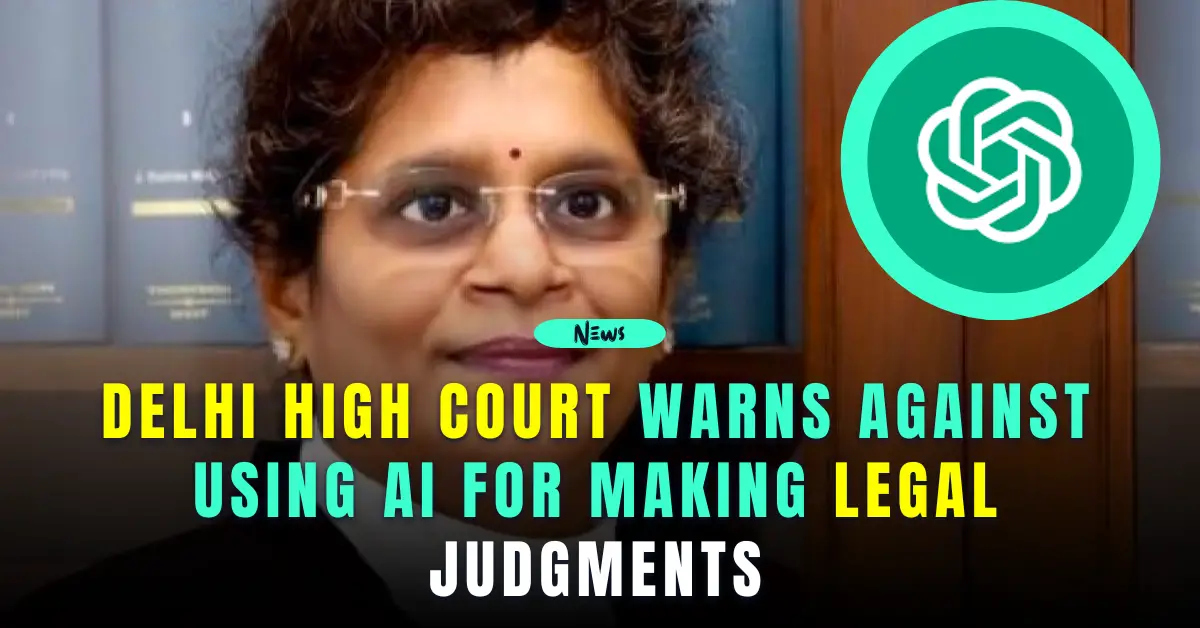
August 27, 2023: The Delhi High Court recently said “no” to using artificial intelligence (AI) in legal cases. The warning came during a case involving Christian Louboutin, a French luxury company known for its unique “red sole” shoe design.
Justice Prathiba M Singh stated, “Accuracy and reliability of AI-generated data is still in the grey area. AI cannot substitute either the human intelligence or the humane element in the adjudicatory process.”
She said that AI could maybe help with early research but should not be used for final legal decisions.@media(min-width:0px){#div-gpt-ad-greataiprompts_com-medrectangle-3-0-asloaded{max-width:580px!important;max-height:400px!important}}
if(typeof ez_ad_units!=’undefined’){ez_ad_units.push([[580,400],’greataiprompts_com-medrectangle-3′,’ezslot_3′,166,’0′,’0′])};__ez_fad_position(‘div-gpt-ad-greataiprompts_com-medrectangle-3-0’);
The court also looked at how AI like ChatGPT gives answers. It said these answers depend on the question and other things, which means AI can sometimes get it wrong. @media(min-width:0px){#div-gpt-ad-greataiprompts_com-medrectangle-4-0-asloaded{max-width:250px!important;max-height:250px!important}}
if(typeof ez_ad_units!=’undefined’){ez_ad_units.push([[250,250],’greataiprompts_com-medrectangle-4′,’ezslot_8′,196,’0′,’0′])};__ez_fad_position(‘div-gpt-ad-greataiprompts_com-medrectangle-4-0’);
“The said tool cannot be the basis of adjudication of legal or factual issues in a court of law,” the court added.
Justice Singh’s comments came after two queries were put to ChatGPT. The AI tool gave answers but also said people should look for more information elsewhere.
The court felt that this shows that AI is not reliable for making legal judgments.
The case also involved Shutiq, a company that was making shoes similar to Christian Louboutin’s. One partner of Shutiq promised the court that they would not copy or sell shoes that look like the luxury brand’s designs in the future.
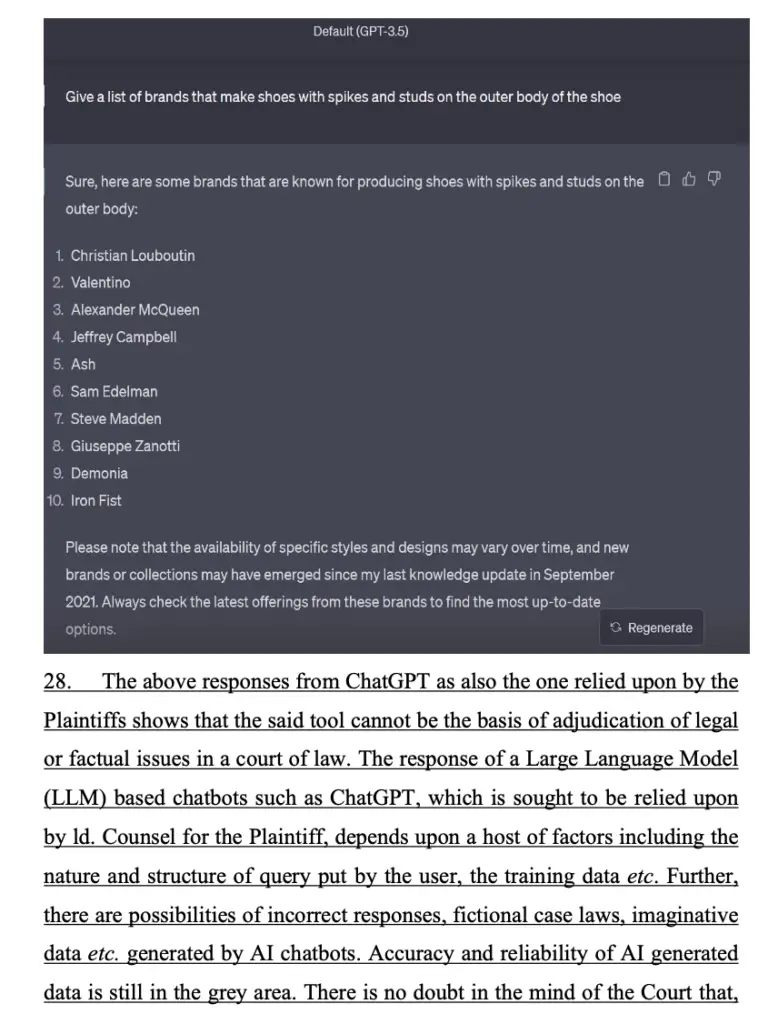
Justice Singh added that for a court to stop someone from making a similar product, it must be a “colourable or a slavish imitation” of the original design. The court made it clear that if there was a breach, the offender would have to pay Christian Louboutin a lump sum of Rs.25 lakhs as damages right away.
@media(min-width:0px){#div-gpt-ad-greataiprompts_com-box-4-0-asloaded{max-width:580px!important;max-height:400px!important}}
if(typeof ez_ad_units!=’undefined’){ez_ad_units.push([[580,400],’greataiprompts_com-box-4′,’ezslot_12′,114,’0′,’0′])};__ez_fad_position(‘div-gpt-ad-greataiprompts_com-box-4-0’);
Read the complete order by Delhi High Court on the use of AI in legal judgments here:
For more in-depth coverage and analysis on the latest developments, visit our Breaking News section. Stay connected and join the conversation by following us on Facebook, and Instagram. Subscribe to our daily newsletter to receive the top headlines and essential stories delivered straight to your inbox. If you have any questions or comments, please contact us. Your feedback is important to us.
31% of Investors Trust AI for Financial Guidance@media(min-width:0px){#div-gpt-ad-greataiprompts_com-box-3-0-asloaded{ma
By Mukund Kapoor, a noted AI enthusiast and contributing author at GreatAiPrompts.Com, specializing in topics related to marketing, artificial intelligence, and innovative AI-driven technologies.
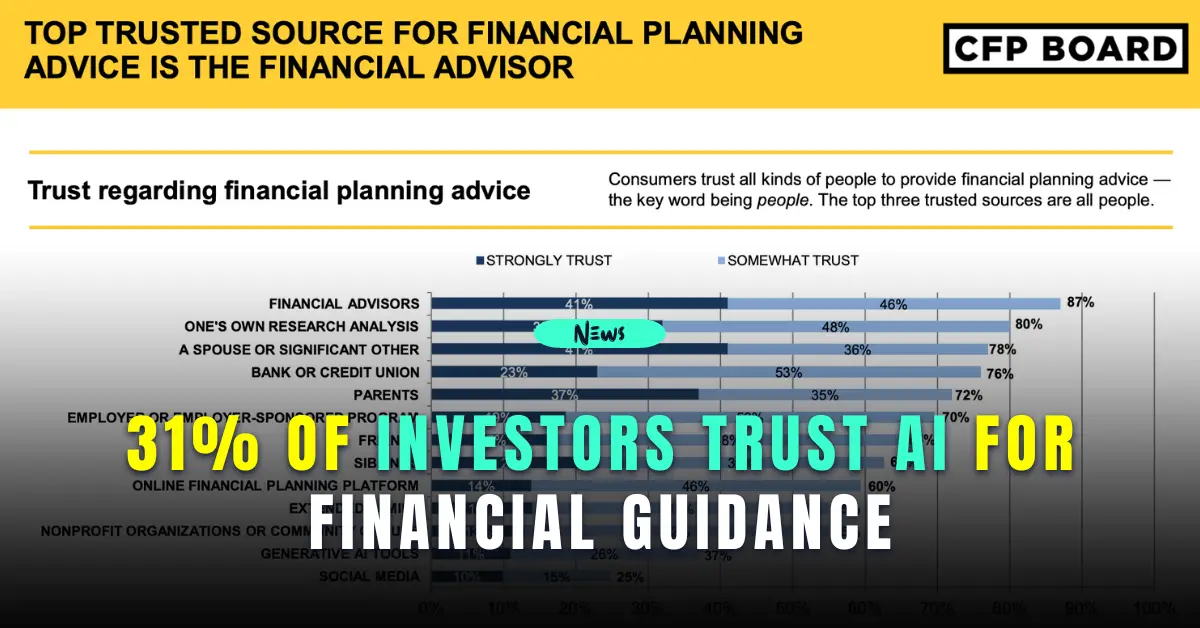
August 25th, 2013: Nearly one out of three investors would trust artificial intelligence (AI) to be their financial advisor, according to a survey by the Certified Financial Planner Board of Standards.
Specifically, 31% of those asked said they would use financial advice from generative AI without checking with another source first.@media(min-width:0px){#div-gpt-ad-greataiprompts_com-medrectangle-3-0-asloaded{max-width:580px!important;max-height:400px!important}}
var cid=’2539763110′;var pid=’ca-pub-8962866323575057′;var slotId=’div-gpt-ad-greataiprompts_com-medrectangle-3-0′;var ffid=1;var alS=1021%1000;var container=document.getElementById(slotId);var ins=document.createElement(‘ins’);ins.id=slotId+’-asloaded’;ins.className=’adsbygoogle ezasloaded’;ins.dataset.adClient=pid;ins.dataset.adChannel=cid;ins.style.display=’block’;ins.style.minWidth=container.attributes.ezaw.value+’px’;ins.style.width=’100%’;ins.style.height=container.attributes.ezah.value+’px’;ins.style.margin=’0px auto’;container.style.maxHeight=container.style.minHeight+’px’;container.style.maxWidth=container.style.minWidth+’px’;container.appendChild(ins);(adsbygoogle=window.adsbygoogle||[]).push({});window.ezoSTPixelAdd(slotId,’stat_source_id’,44);window.ezoSTPixelAdd(slotId,’adsensetype’,1);var lo=new MutationObserver(window.ezaslEvent);lo.observe(document.getElementById(slotId+’-asloaded’),{attributes:true});
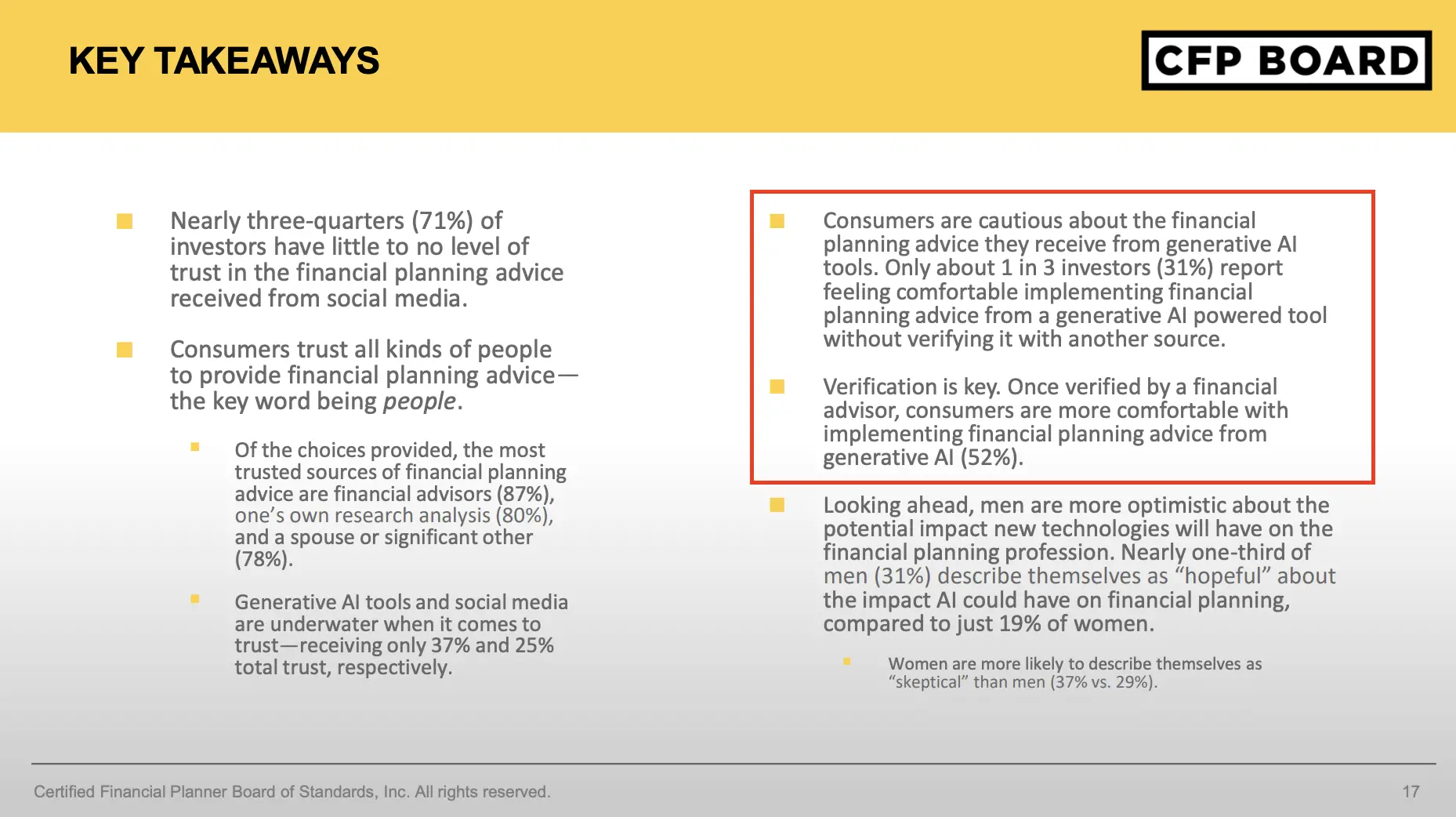
Generative AI, like ChatGPT, uses special methods to create new content. This can be art, music, or in this case, financial advice. But the advice might not always be right.
Kevin Keller, the head of the CFP Board, said that AI’s advice isn’t always correct. He added, “It’s the Wild West out there.”
An interesting finding was that older investors, those 45 and older, trusted AI more. 62% of them were “very satisfied” with AI advice, compared to only 38% of younger investors.
@media(min-width:0px){#div-gpt-ad-greataiprompts_com-medrectangle-4-0-asloaded{max-width:300px!important;max-height:250px!important}}
if(typeof ez_ad_units!=’undefined’){ez_ad_units.push([[300,250],’greataiprompts_com-medrectangle-4′,’ezslot_8′,113,’0′,’0′])};__ez_fad_position(‘div-gpt-ad-greataiprompts_com-medrectangle-4-0’);
Michael Kitces, a Certified Financial Planner, said it could be hard to know what to ask AI, especially with your life savings at stake. He asked, “Have you tried logging into ChatGPT to ask it questions only to find yourself sitting there wondering, ‘What should I ask an AI chatbot?’”
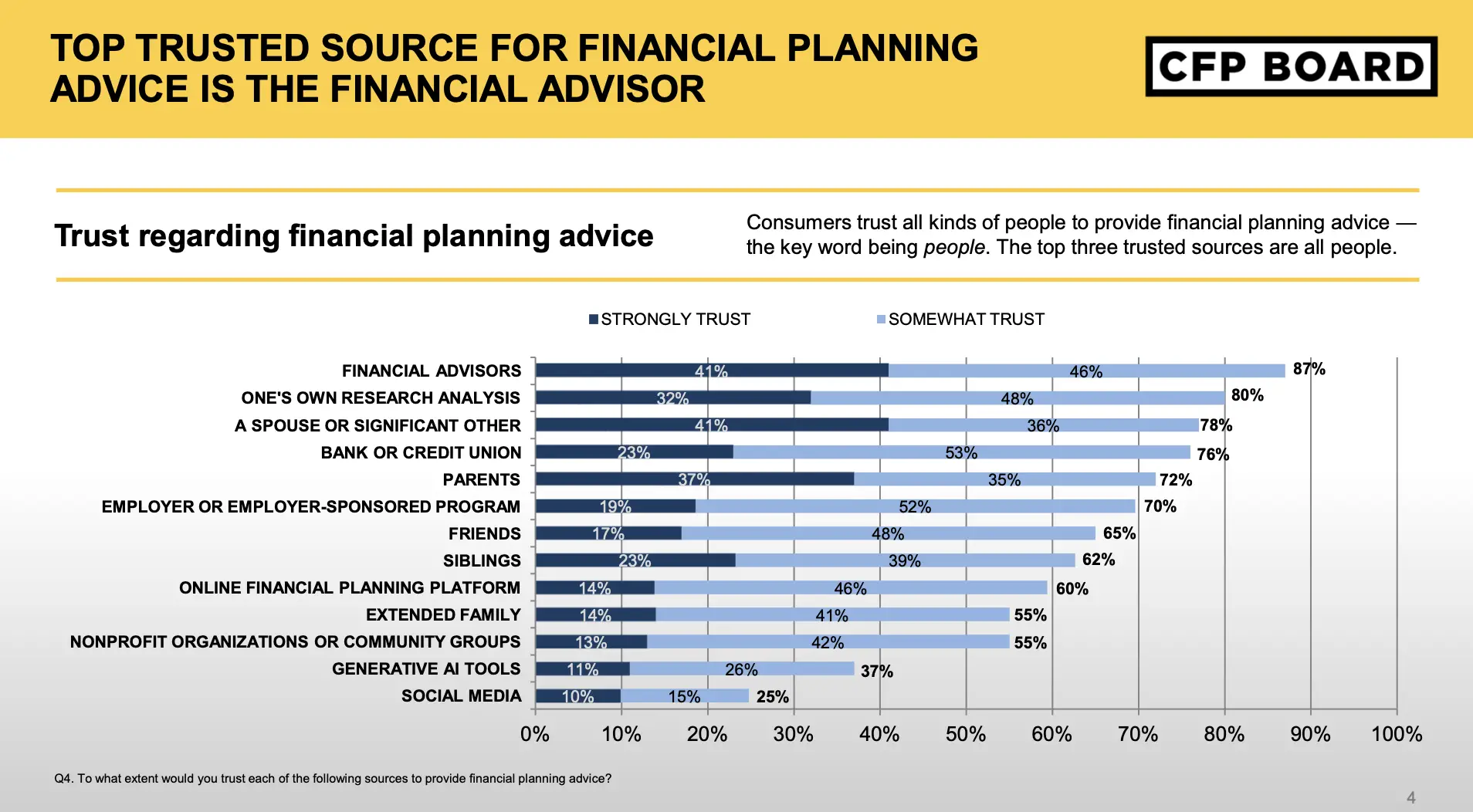
Even though AI like ChatGPT is becoming more popular, experts say that people who use AI for financial advice should still check the information. @media(min-width:0px){#div-gpt-ad-greataiprompts_com-box-4-0-asloaded{max-width:250px!important;max-height:250px!important}}
if(typeof ez_ad_units!=’undefined’){ez_ad_units.push([[250,250],’greataiprompts_com-box-4′,’ezslot_10′,168,’0′,’0′])};__ez_fad_position(‘div-gpt-ad-greataiprompts_com-box-4-0’);
The saying “trust but verify” is a good rule to follow.
For more in-depth coverage and analysis on the latest developments, visit our Breaking News section. Stay connected and join the conversation by following us on Facebook, and Instagram. Subscribe to our daily newsletter to receive the top headlines and essential stories delivered straight to your inbox. If you have any questions or comments, please contact us. Your feedback is important to us.
